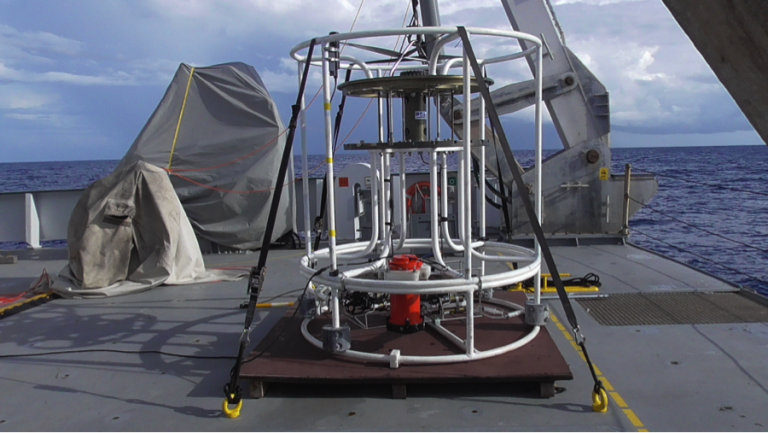
Similar in shape to a fire hydrant, the Lowered Acoustic Doppler Current Profiler (LADCP) is fastened to the CTD (Conductivity, Temperature and Depth) Rosette, a white, jungle gym-like structure. Therefore, each ADCP drop also requires a CTD deployment. The ADCP itself is light and requires no special lifting equipment, but the CTD is quite heavy, and is deployed using Falkor’s A-Frame. ADCP’s come in many forms, and Falkor also has two of these instruments attached to the hull of the ship.
Doppler effect

Sound wave frequency is directly related to the sound we hear. For example, a wailing siren on an ambulance sounds high pitched when it’s moving toward you, but as it moves away, the pitch lowers, which signifies a lower frequency of sound waves. This change in pitch is directly proportional to how fast the ambulance is moving. Therefore, if you measure the pitch and how much it changes, you can calculate the speed of the ambulance. This concept is described as the Doppler effect, and it’s the same principle that the ADCP is designed on.
How ADCPs use sound to measure velocity
The lowered ADCP has four transducers on the bottom (as seen in the photo to the left), which send and receive acoustic signals. Using the Doppler effect, the ADCP transmits sound at a particular frequency and listens for the sound to return after bouncing off sound scatters in the water. We assume the small particles or plankton are floating in the water with the same average horizontal velocity as the water. These particles reflect back some of the sound.
To record an echo, you need the beam to bounce straight back. Beams scattered in other directions never make it back to the transducer to be recorded. When signals bounce back, we use the frequency shift to calculate the velocity of the layers of water. These calculations are made possible by all four beams recording the same velocity of each layer. In the ocean, rivers, and lakes, horizontal layers usually have the same velocity.

Four Beams

To construct velocity you only need three beams. Each beam gives us a dimension, so with four beams, we have all three dimensions plus an extra beam. If one of the beams gives bad data, it can be removed without compromising velocity construction. Otherwise, the fourth beam is a built-in means to evaluate quality of incoming data.
Calculations

When the ADCP is lowered, we don’t know exactly from which direction it will ping the layers or at exactly what speed. To remedy these unknowns, the ADCP has a system that allows for various kinds of motion correction. Ultimately, we use ADCP data to determine the difference in velocity of the layers. This allows the scientists onboard to locate areas of large-scale shear, which you can learn more about here.

